Nursing Assignment: Exploring Aging, Weight Loss, and Obesity
VerifiedAdded on 2022/09/18
|8
|2318
|24
Essay
AI Summary
This nursing assignment analyzes the relationship between aging, weight loss, and obesity, particularly among older adults. It reviews existing literature, highlighting the impact of obesity on health outcomes such as bone loss, sarcopenia, and overall quality of life. The essay examines various interventions, including lifestyle modifications like calorie restriction and exercise, and assesses their effectiveness in promoting weight loss and improving health indicators. It also discusses the importance of considering functional status and quality of life when evaluating the success of interventions. The assignment references several studies and reviews, emphasizing the need for further research to address the long-term maintenance of weight loss, the impact on lean body mass and bone health, and the role of inflammatory mechanisms. Overall, the essay underscores the significance of addressing obesity in older adults to improve health outcomes and reduce healthcare costs. This assignment is available on Desklib, a platform providing AI-based study tools for students.
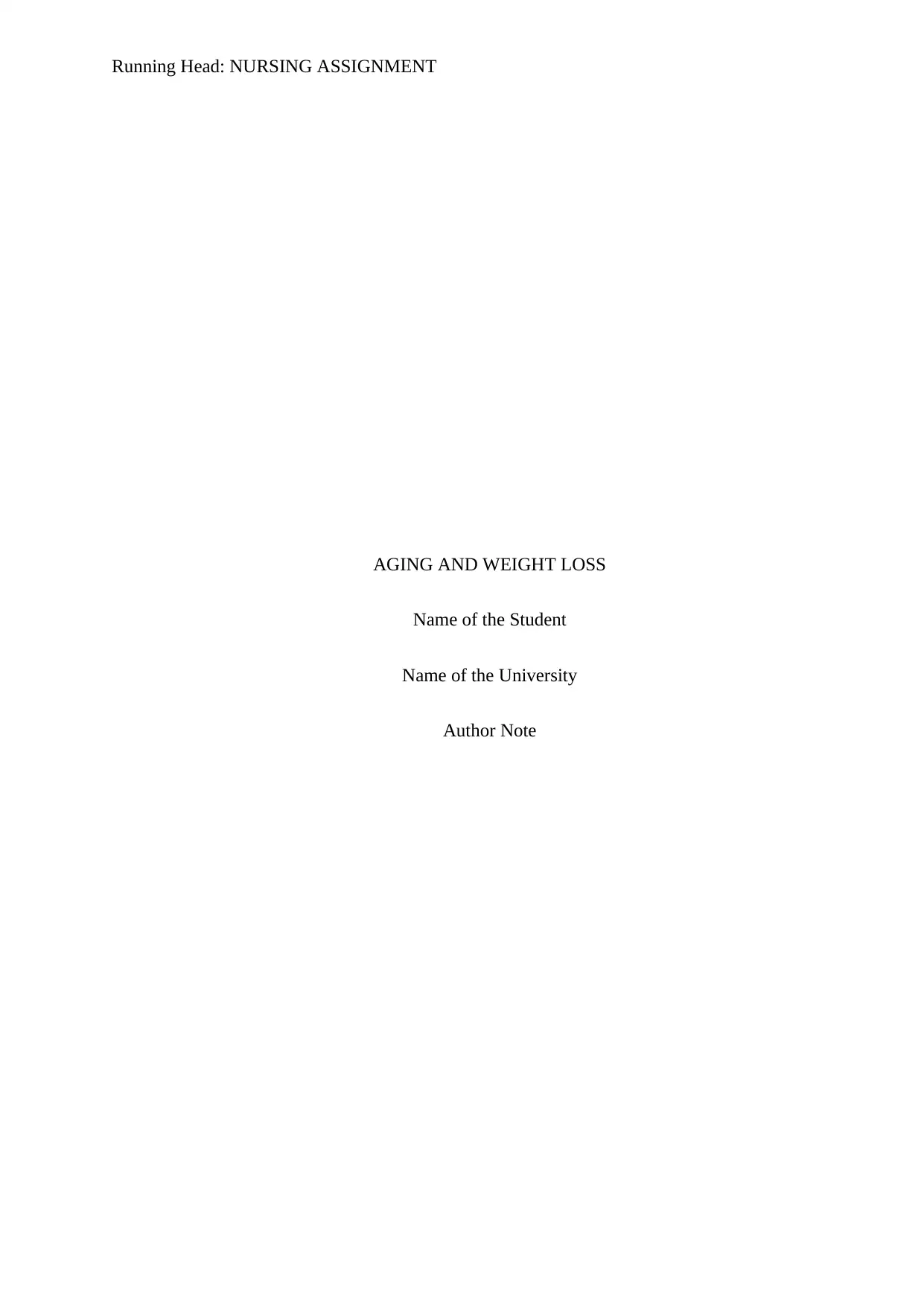
Running Head: NURSING ASSIGNMENT
AGING AND WEIGHT LOSS
Name of the Student
Name of the University
Author Note
AGING AND WEIGHT LOSS
Name of the Student
Name of the University
Author Note
Paraphrase This Document
Need a fresh take? Get an instant paraphrase of this document with our AI Paraphraser
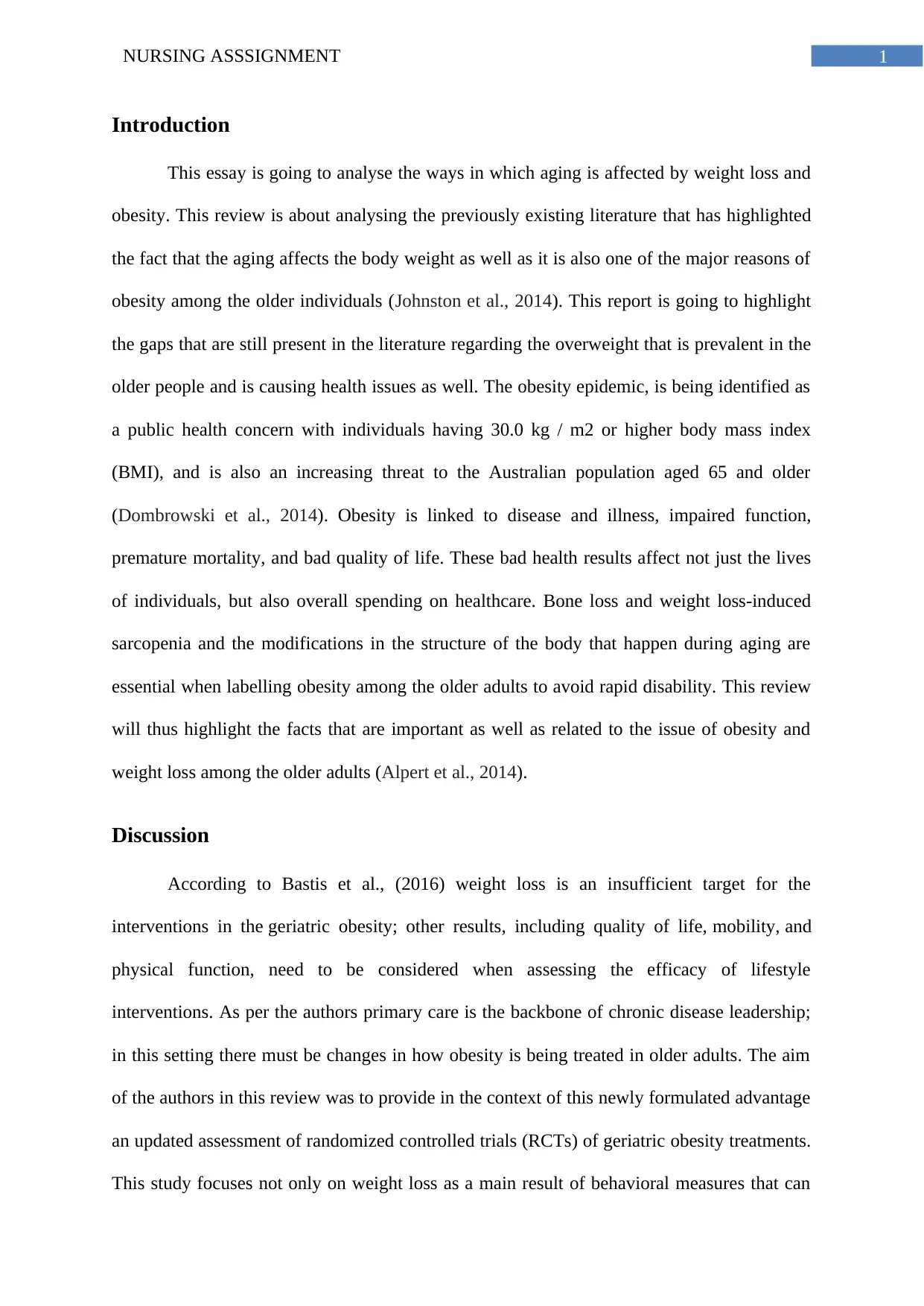
1NURSING ASSSIGNMENT
Introduction
This essay is going to analyse the ways in which aging is affected by weight loss and
obesity. This review is about analysing the previously existing literature that has highlighted
the fact that the aging affects the body weight as well as it is also one of the major reasons of
obesity among the older individuals (Johnston et al., 2014). This report is going to highlight
the gaps that are still present in the literature regarding the overweight that is prevalent in the
older people and is causing health issues as well. The obesity epidemic, is being identified as
a public health concern with individuals having 30.0 kg / m2 or higher body mass index
(BMI), and is also an increasing threat to the Australian population aged 65 and older
(Dombrowski et al., 2014). Obesity is linked to disease and illness, impaired function,
premature mortality, and bad quality of life. These bad health results affect not just the lives
of individuals, but also overall spending on healthcare. Bone loss and weight loss-induced
sarcopenia and the modifications in the structure of the body that happen during aging are
essential when labelling obesity among the older adults to avoid rapid disability. This review
will thus highlight the facts that are important as well as related to the issue of obesity and
weight loss among the older adults (Alpert et al., 2014).
Discussion
According to Bastis et al., (2016) weight loss is an insufficient target for the
interventions in the geriatric obesity; other results, including quality of life, mobility, and
physical function, need to be considered when assessing the efficacy of lifestyle
interventions. As per the authors primary care is the backbone of chronic disease leadership;
in this setting there must be changes in how obesity is being treated in older adults. The aim
of the authors in this review was to provide in the context of this newly formulated advantage
an updated assessment of randomized controlled trials (RCTs) of geriatric obesity treatments.
This study focuses not only on weight loss as a main result of behavioral measures that can
Introduction
This essay is going to analyse the ways in which aging is affected by weight loss and
obesity. This review is about analysing the previously existing literature that has highlighted
the fact that the aging affects the body weight as well as it is also one of the major reasons of
obesity among the older individuals (Johnston et al., 2014). This report is going to highlight
the gaps that are still present in the literature regarding the overweight that is prevalent in the
older people and is causing health issues as well. The obesity epidemic, is being identified as
a public health concern with individuals having 30.0 kg / m2 or higher body mass index
(BMI), and is also an increasing threat to the Australian population aged 65 and older
(Dombrowski et al., 2014). Obesity is linked to disease and illness, impaired function,
premature mortality, and bad quality of life. These bad health results affect not just the lives
of individuals, but also overall spending on healthcare. Bone loss and weight loss-induced
sarcopenia and the modifications in the structure of the body that happen during aging are
essential when labelling obesity among the older adults to avoid rapid disability. This review
will thus highlight the facts that are important as well as related to the issue of obesity and
weight loss among the older adults (Alpert et al., 2014).
Discussion
According to Bastis et al., (2016) weight loss is an insufficient target for the
interventions in the geriatric obesity; other results, including quality of life, mobility, and
physical function, need to be considered when assessing the efficacy of lifestyle
interventions. As per the authors primary care is the backbone of chronic disease leadership;
in this setting there must be changes in how obesity is being treated in older adults. The aim
of the authors in this review was to provide in the context of this newly formulated advantage
an updated assessment of randomized controlled trials (RCTs) of geriatric obesity treatments.
This study focuses not only on weight loss as a main result of behavioral measures that can
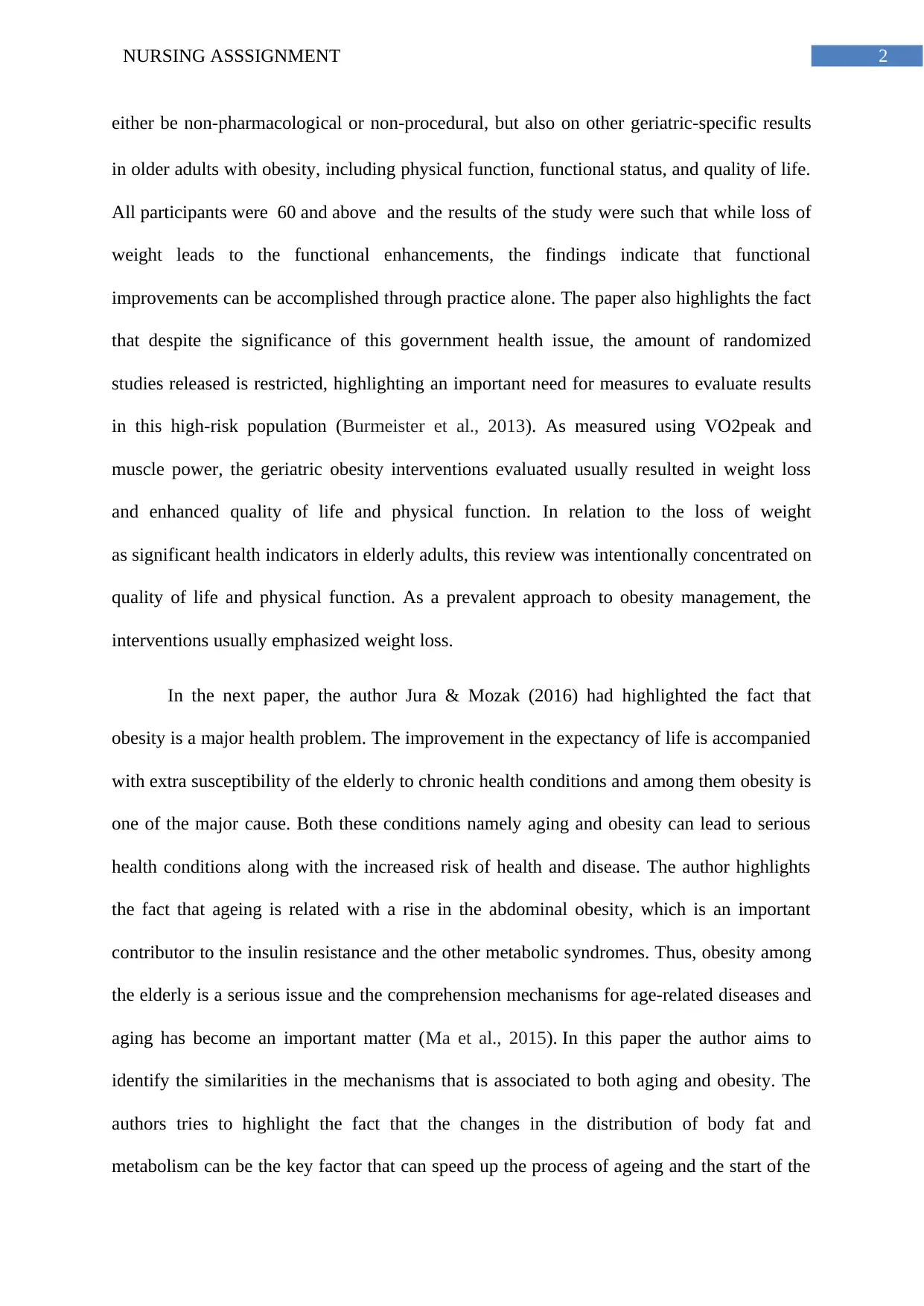
2NURSING ASSSIGNMENT
either be non-pharmacological or non-procedural, but also on other geriatric-specific results
in older adults with obesity, including physical function, functional status, and quality of life.
All participants were 60 and above and the results of the study were such that while loss of
weight leads to the functional enhancements, the findings indicate that functional
improvements can be accomplished through practice alone. The paper also highlights the fact
that despite the significance of this government health issue, the amount of randomized
studies released is restricted, highlighting an important need for measures to evaluate results
in this high-risk population (Burmeister et al., 2013). As measured using VO2peak and
muscle power, the geriatric obesity interventions evaluated usually resulted in weight loss
and enhanced quality of life and physical function. In relation to the loss of weight
as significant health indicators in elderly adults, this review was intentionally concentrated on
quality of life and physical function. As a prevalent approach to obesity management, the
interventions usually emphasized weight loss.
In the next paper, the author Jura & Mozak (2016) had highlighted the fact that
obesity is a major health problem. The improvement in the expectancy of life is accompanied
with extra susceptibility of the elderly to chronic health conditions and among them obesity is
one of the major cause. Both these conditions namely aging and obesity can lead to serious
health conditions along with the increased risk of health and disease. The author highlights
the fact that ageing is related with a rise in the abdominal obesity, which is an important
contributor to the insulin resistance and the other metabolic syndromes. Thus, obesity among
the elderly is a serious issue and the comprehension mechanisms for age-related diseases and
aging has become an important matter (Ma et al., 2015). In this paper the author aims to
identify the similarities in the mechanisms that is associated to both aging and obesity. The
authors tries to highlight the fact that the changes in the distribution of body fat and
metabolism can be the key factor that can speed up the process of ageing and the start of the
either be non-pharmacological or non-procedural, but also on other geriatric-specific results
in older adults with obesity, including physical function, functional status, and quality of life.
All participants were 60 and above and the results of the study were such that while loss of
weight leads to the functional enhancements, the findings indicate that functional
improvements can be accomplished through practice alone. The paper also highlights the fact
that despite the significance of this government health issue, the amount of randomized
studies released is restricted, highlighting an important need for measures to evaluate results
in this high-risk population (Burmeister et al., 2013). As measured using VO2peak and
muscle power, the geriatric obesity interventions evaluated usually resulted in weight loss
and enhanced quality of life and physical function. In relation to the loss of weight
as significant health indicators in elderly adults, this review was intentionally concentrated on
quality of life and physical function. As a prevalent approach to obesity management, the
interventions usually emphasized weight loss.
In the next paper, the author Jura & Mozak (2016) had highlighted the fact that
obesity is a major health problem. The improvement in the expectancy of life is accompanied
with extra susceptibility of the elderly to chronic health conditions and among them obesity is
one of the major cause. Both these conditions namely aging and obesity can lead to serious
health conditions along with the increased risk of health and disease. The author highlights
the fact that ageing is related with a rise in the abdominal obesity, which is an important
contributor to the insulin resistance and the other metabolic syndromes. Thus, obesity among
the elderly is a serious issue and the comprehension mechanisms for age-related diseases and
aging has become an important matter (Ma et al., 2015). In this paper the author aims to
identify the similarities in the mechanisms that is associated to both aging and obesity. The
authors tries to highlight the fact that the changes in the distribution of body fat and
metabolism can be the key factor that can speed up the process of ageing and the start of the
⊘ This is a preview!⊘
Do you want full access?
Subscribe today to unlock all pages.

Trusted by 1+ million students worldwide
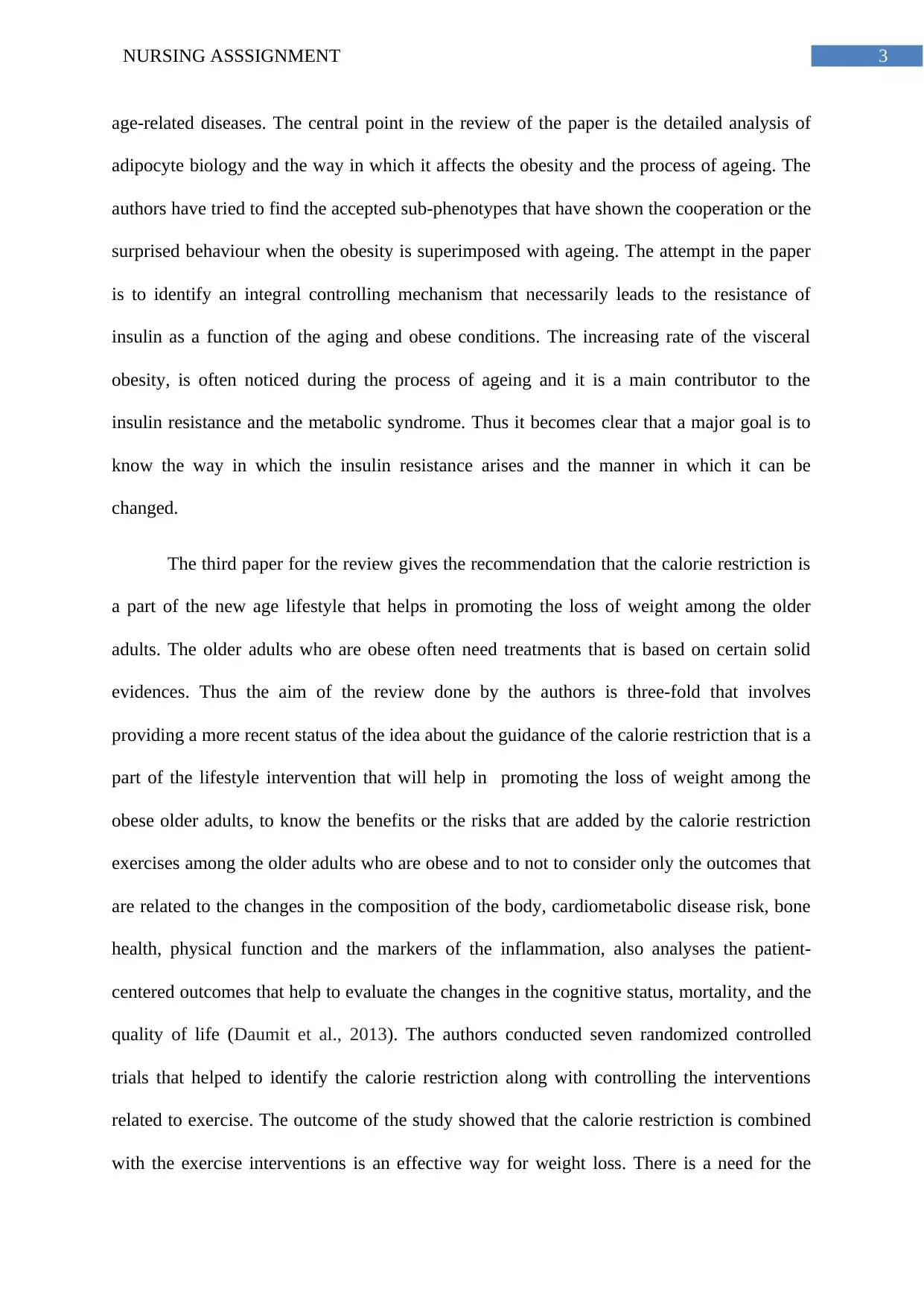
3NURSING ASSSIGNMENT
age-related diseases. The central point in the review of the paper is the detailed analysis of
adipocyte biology and the way in which it affects the obesity and the process of ageing. The
authors have tried to find the accepted sub-phenotypes that have shown the cooperation or the
surprised behaviour when the obesity is superimposed with ageing. The attempt in the paper
is to identify an integral controlling mechanism that necessarily leads to the resistance of
insulin as a function of the aging and obese conditions. The increasing rate of the visceral
obesity, is often noticed during the process of ageing and it is a main contributor to the
insulin resistance and the metabolic syndrome. Thus it becomes clear that a major goal is to
know the way in which the insulin resistance arises and the manner in which it can be
changed.
The third paper for the review gives the recommendation that the calorie restriction is
a part of the new age lifestyle that helps in promoting the loss of weight among the older
adults. The older adults who are obese often need treatments that is based on certain solid
evidences. Thus the aim of the review done by the authors is three-fold that involves
providing a more recent status of the idea about the guidance of the calorie restriction that is a
part of the lifestyle intervention that will help in promoting the loss of weight among the
obese older adults, to know the benefits or the risks that are added by the calorie restriction
exercises among the older adults who are obese and to not to consider only the outcomes that
are related to the changes in the composition of the body, cardiometabolic disease risk, bone
health, physical function and the markers of the inflammation, also analyses the patient-
centered outcomes that help to evaluate the changes in the cognitive status, mortality, and the
quality of life (Daumit et al., 2013). The authors conducted seven randomized controlled
trials that helped to identify the calorie restriction along with controlling the interventions
related to exercise. The outcome of the study showed that the calorie restriction is combined
with the exercise interventions is an effective way for weight loss. There is a need for the
age-related diseases. The central point in the review of the paper is the detailed analysis of
adipocyte biology and the way in which it affects the obesity and the process of ageing. The
authors have tried to find the accepted sub-phenotypes that have shown the cooperation or the
surprised behaviour when the obesity is superimposed with ageing. The attempt in the paper
is to identify an integral controlling mechanism that necessarily leads to the resistance of
insulin as a function of the aging and obese conditions. The increasing rate of the visceral
obesity, is often noticed during the process of ageing and it is a main contributor to the
insulin resistance and the metabolic syndrome. Thus it becomes clear that a major goal is to
know the way in which the insulin resistance arises and the manner in which it can be
changed.
The third paper for the review gives the recommendation that the calorie restriction is
a part of the new age lifestyle that helps in promoting the loss of weight among the older
adults. The older adults who are obese often need treatments that is based on certain solid
evidences. Thus the aim of the review done by the authors is three-fold that involves
providing a more recent status of the idea about the guidance of the calorie restriction that is a
part of the lifestyle intervention that will help in promoting the loss of weight among the
obese older adults, to know the benefits or the risks that are added by the calorie restriction
exercises among the older adults who are obese and to not to consider only the outcomes that
are related to the changes in the composition of the body, cardiometabolic disease risk, bone
health, physical function and the markers of the inflammation, also analyses the patient-
centered outcomes that help to evaluate the changes in the cognitive status, mortality, and the
quality of life (Daumit et al., 2013). The authors conducted seven randomized controlled
trials that helped to identify the calorie restriction along with controlling the interventions
related to exercise. The outcome of the study showed that the calorie restriction is combined
with the exercise interventions is an effective way for weight loss. There is a need for the
Paraphrase This Document
Need a fresh take? Get an instant paraphrase of this document with our AI Paraphraser
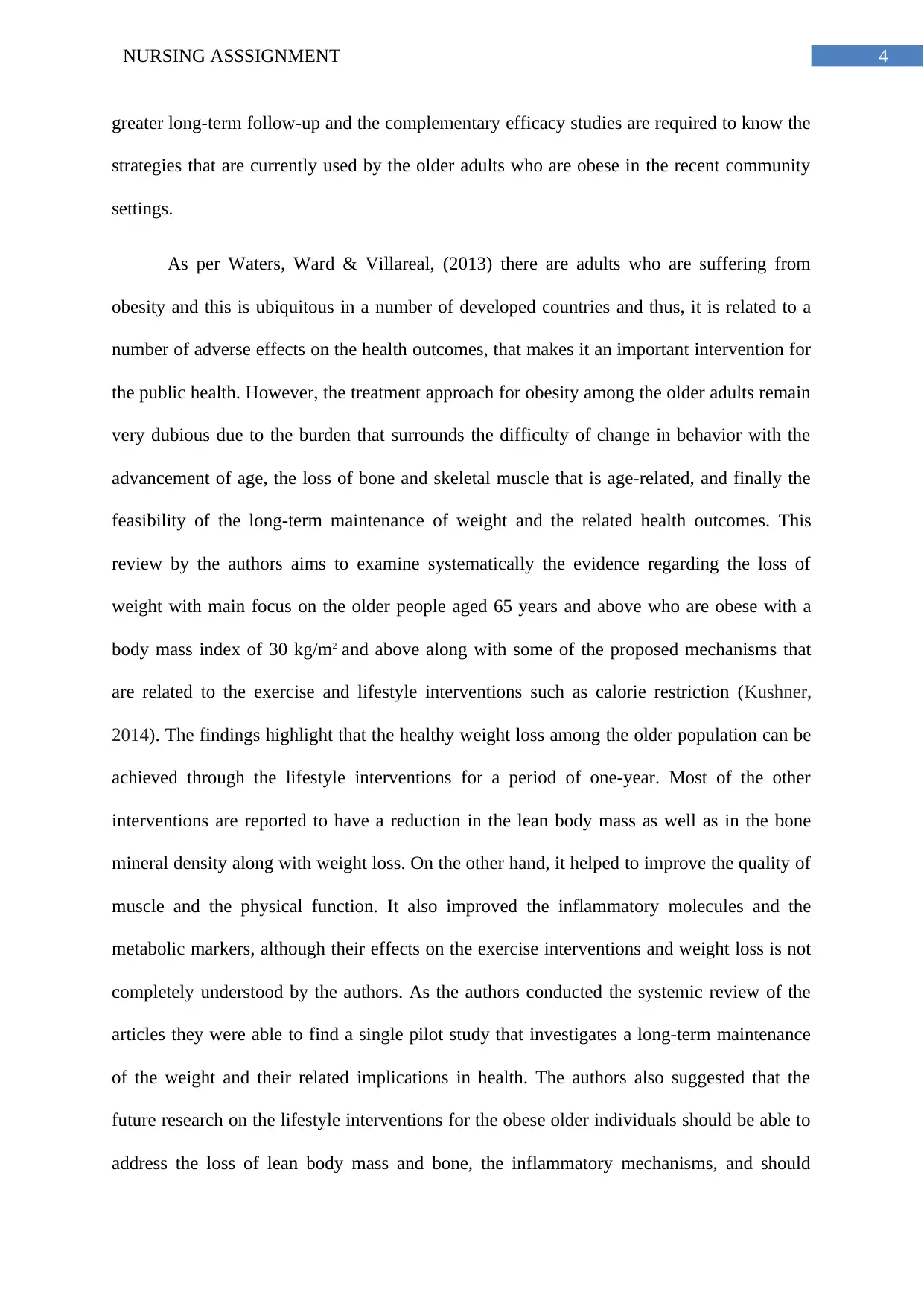
4NURSING ASSSIGNMENT
greater long-term follow-up and the complementary efficacy studies are required to know the
strategies that are currently used by the older adults who are obese in the recent community
settings.
As per Waters, Ward & Villareal, (2013) there are adults who are suffering from
obesity and this is ubiquitous in a number of developed countries and thus, it is related to a
number of adverse effects on the health outcomes, that makes it an important intervention for
the public health. However, the treatment approach for obesity among the older adults remain
very dubious due to the burden that surrounds the difficulty of change in behavior with the
advancement of age, the loss of bone and skeletal muscle that is age-related, and finally the
feasibility of the long-term maintenance of weight and the related health outcomes. This
review by the authors aims to examine systematically the evidence regarding the loss of
weight with main focus on the older people aged 65 years and above who are obese with a
body mass index of 30 kg/m2 and above along with some of the proposed mechanisms that
are related to the exercise and lifestyle interventions such as calorie restriction (Kushner,
2014). The findings highlight that the healthy weight loss among the older population can be
achieved through the lifestyle interventions for a period of one-year. Most of the other
interventions are reported to have a reduction in the lean body mass as well as in the bone
mineral density along with weight loss. On the other hand, it helped to improve the quality of
muscle and the physical function. It also improved the inflammatory molecules and the
metabolic markers, although their effects on the exercise interventions and weight loss is not
completely understood by the authors. As the authors conducted the systemic review of the
articles they were able to find a single pilot study that investigates a long-term maintenance
of the weight and their related implications in health. The authors also suggested that the
future research on the lifestyle interventions for the obese older individuals should be able to
address the loss of lean body mass and bone, the inflammatory mechanisms, and should
greater long-term follow-up and the complementary efficacy studies are required to know the
strategies that are currently used by the older adults who are obese in the recent community
settings.
As per Waters, Ward & Villareal, (2013) there are adults who are suffering from
obesity and this is ubiquitous in a number of developed countries and thus, it is related to a
number of adverse effects on the health outcomes, that makes it an important intervention for
the public health. However, the treatment approach for obesity among the older adults remain
very dubious due to the burden that surrounds the difficulty of change in behavior with the
advancement of age, the loss of bone and skeletal muscle that is age-related, and finally the
feasibility of the long-term maintenance of weight and the related health outcomes. This
review by the authors aims to examine systematically the evidence regarding the loss of
weight with main focus on the older people aged 65 years and above who are obese with a
body mass index of 30 kg/m2 and above along with some of the proposed mechanisms that
are related to the exercise and lifestyle interventions such as calorie restriction (Kushner,
2014). The findings highlight that the healthy weight loss among the older population can be
achieved through the lifestyle interventions for a period of one-year. Most of the other
interventions are reported to have a reduction in the lean body mass as well as in the bone
mineral density along with weight loss. On the other hand, it helped to improve the quality of
muscle and the physical function. It also improved the inflammatory molecules and the
metabolic markers, although their effects on the exercise interventions and weight loss is not
completely understood by the authors. As the authors conducted the systemic review of the
articles they were able to find a single pilot study that investigates a long-term maintenance
of the weight and their related implications in health. The authors also suggested that the
future research on the lifestyle interventions for the obese older individuals should be able to
address the loss of lean body mass and bone, the inflammatory mechanisms, and should
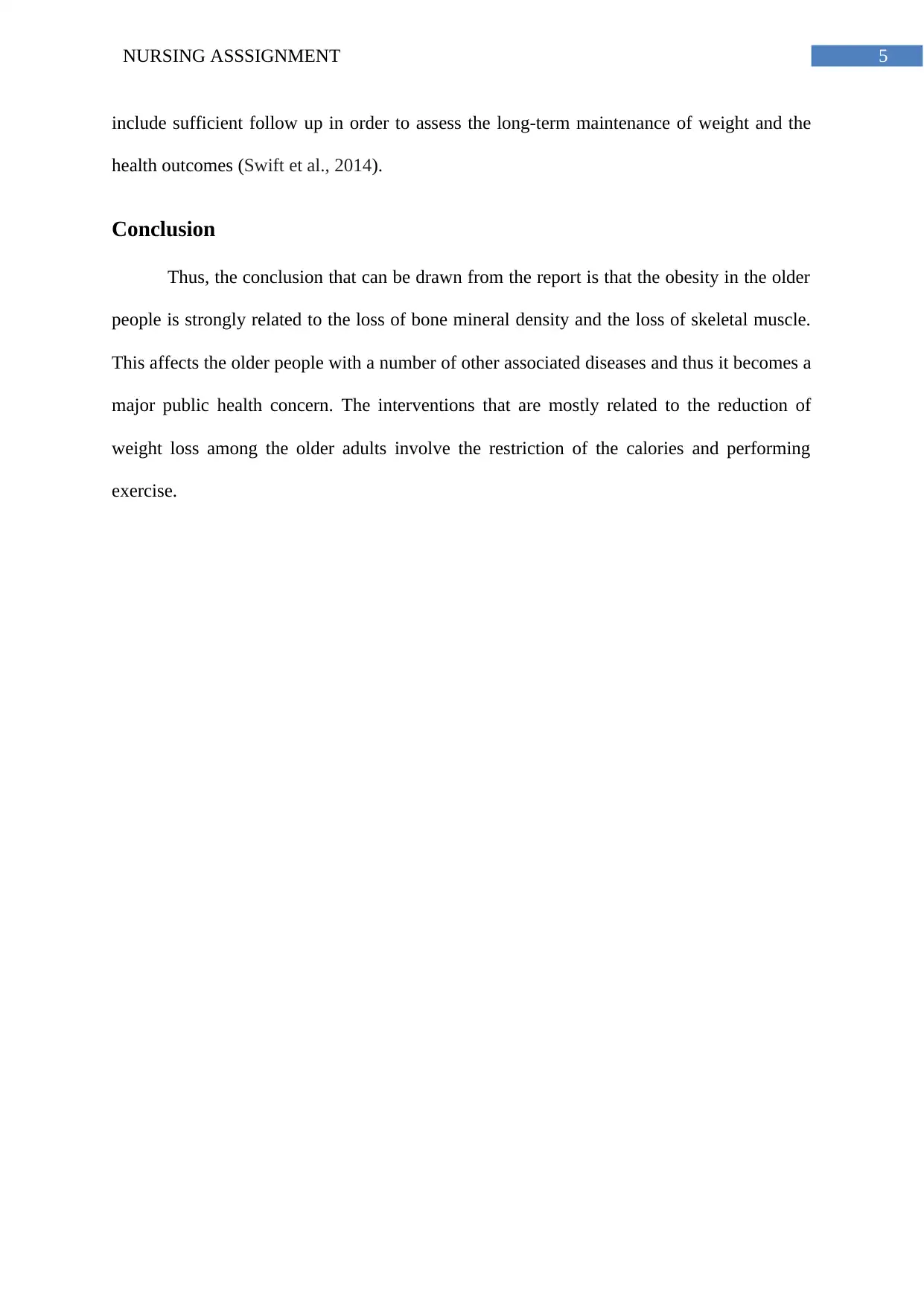
5NURSING ASSSIGNMENT
include sufficient follow up in order to assess the long-term maintenance of weight and the
health outcomes (Swift et al., 2014).
Conclusion
Thus, the conclusion that can be drawn from the report is that the obesity in the older
people is strongly related to the loss of bone mineral density and the loss of skeletal muscle.
This affects the older people with a number of other associated diseases and thus it becomes a
major public health concern. The interventions that are mostly related to the reduction of
weight loss among the older adults involve the restriction of the calories and performing
exercise.
include sufficient follow up in order to assess the long-term maintenance of weight and the
health outcomes (Swift et al., 2014).
Conclusion
Thus, the conclusion that can be drawn from the report is that the obesity in the older
people is strongly related to the loss of bone mineral density and the loss of skeletal muscle.
This affects the older people with a number of other associated diseases and thus it becomes a
major public health concern. The interventions that are mostly related to the reduction of
weight loss among the older adults involve the restriction of the calories and performing
exercise.
⊘ This is a preview!⊘
Do you want full access?
Subscribe today to unlock all pages.

Trusted by 1+ million students worldwide
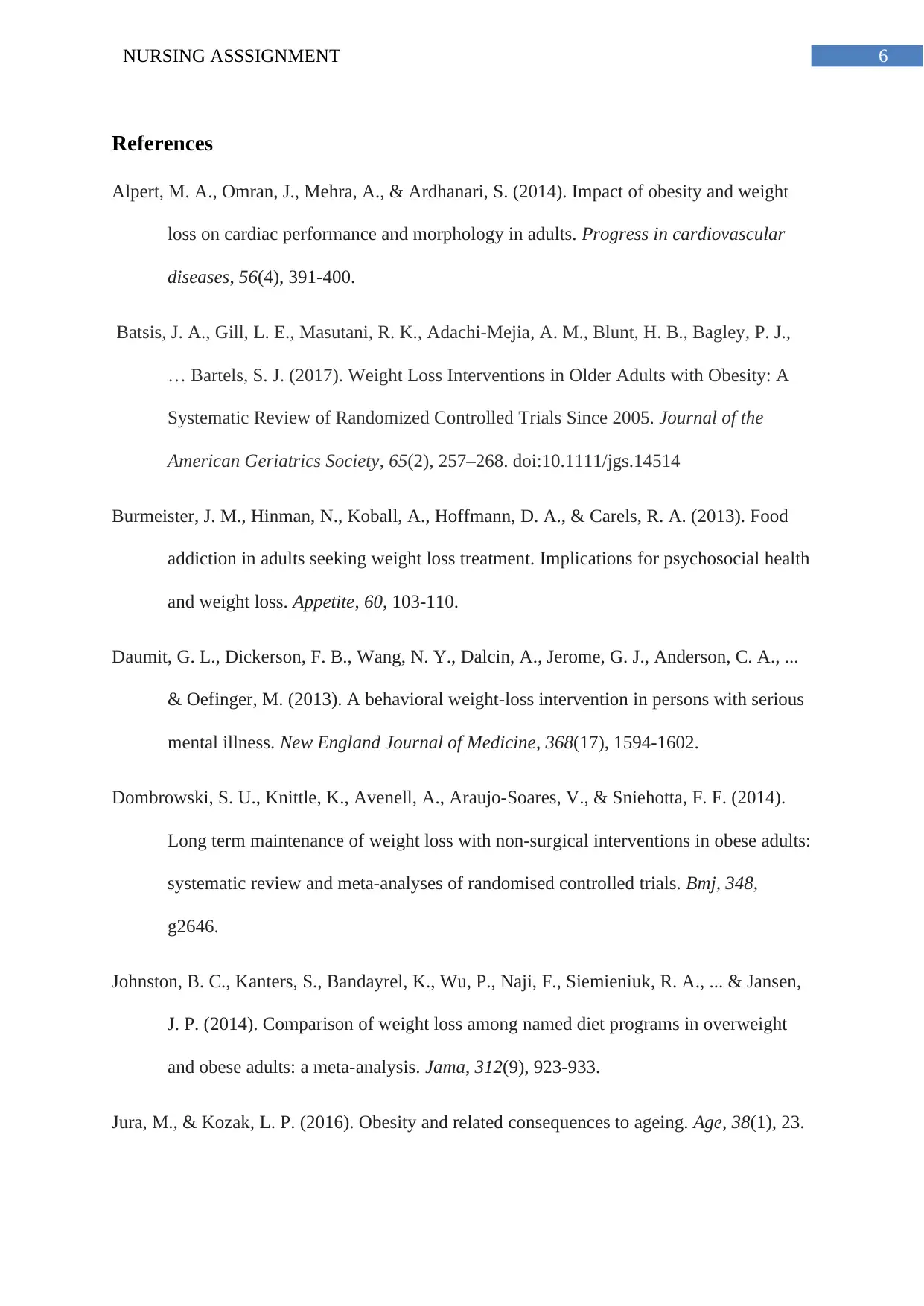
6NURSING ASSSIGNMENT
References
Alpert, M. A., Omran, J., Mehra, A., & Ardhanari, S. (2014). Impact of obesity and weight
loss on cardiac performance and morphology in adults. Progress in cardiovascular
diseases, 56(4), 391-400.
Batsis, J. A., Gill, L. E., Masutani, R. K., Adachi-Mejia, A. M., Blunt, H. B., Bagley, P. J.,
… Bartels, S. J. (2017). Weight Loss Interventions in Older Adults with Obesity: A
Systematic Review of Randomized Controlled Trials Since 2005. Journal of the
American Geriatrics Society, 65(2), 257–268. doi:10.1111/jgs.14514
Burmeister, J. M., Hinman, N., Koball, A., Hoffmann, D. A., & Carels, R. A. (2013). Food
addiction in adults seeking weight loss treatment. Implications for psychosocial health
and weight loss. Appetite, 60, 103-110.
Daumit, G. L., Dickerson, F. B., Wang, N. Y., Dalcin, A., Jerome, G. J., Anderson, C. A., ...
& Oefinger, M. (2013). A behavioral weight-loss intervention in persons with serious
mental illness. New England Journal of Medicine, 368(17), 1594-1602.
Dombrowski, S. U., Knittle, K., Avenell, A., Araujo-Soares, V., & Sniehotta, F. F. (2014).
Long term maintenance of weight loss with non-surgical interventions in obese adults:
systematic review and meta-analyses of randomised controlled trials. Bmj, 348,
g2646.
Johnston, B. C., Kanters, S., Bandayrel, K., Wu, P., Naji, F., Siemieniuk, R. A., ... & Jansen,
J. P. (2014). Comparison of weight loss among named diet programs in overweight
and obese adults: a meta-analysis. Jama, 312(9), 923-933.
Jura, M., & Kozak, L. P. (2016). Obesity and related consequences to ageing. Age, 38(1), 23.
References
Alpert, M. A., Omran, J., Mehra, A., & Ardhanari, S. (2014). Impact of obesity and weight
loss on cardiac performance and morphology in adults. Progress in cardiovascular
diseases, 56(4), 391-400.
Batsis, J. A., Gill, L. E., Masutani, R. K., Adachi-Mejia, A. M., Blunt, H. B., Bagley, P. J.,
… Bartels, S. J. (2017). Weight Loss Interventions in Older Adults with Obesity: A
Systematic Review of Randomized Controlled Trials Since 2005. Journal of the
American Geriatrics Society, 65(2), 257–268. doi:10.1111/jgs.14514
Burmeister, J. M., Hinman, N., Koball, A., Hoffmann, D. A., & Carels, R. A. (2013). Food
addiction in adults seeking weight loss treatment. Implications for psychosocial health
and weight loss. Appetite, 60, 103-110.
Daumit, G. L., Dickerson, F. B., Wang, N. Y., Dalcin, A., Jerome, G. J., Anderson, C. A., ...
& Oefinger, M. (2013). A behavioral weight-loss intervention in persons with serious
mental illness. New England Journal of Medicine, 368(17), 1594-1602.
Dombrowski, S. U., Knittle, K., Avenell, A., Araujo-Soares, V., & Sniehotta, F. F. (2014).
Long term maintenance of weight loss with non-surgical interventions in obese adults:
systematic review and meta-analyses of randomised controlled trials. Bmj, 348,
g2646.
Johnston, B. C., Kanters, S., Bandayrel, K., Wu, P., Naji, F., Siemieniuk, R. A., ... & Jansen,
J. P. (2014). Comparison of weight loss among named diet programs in overweight
and obese adults: a meta-analysis. Jama, 312(9), 923-933.
Jura, M., & Kozak, L. P. (2016). Obesity and related consequences to ageing. Age, 38(1), 23.
Paraphrase This Document
Need a fresh take? Get an instant paraphrase of this document with our AI Paraphraser
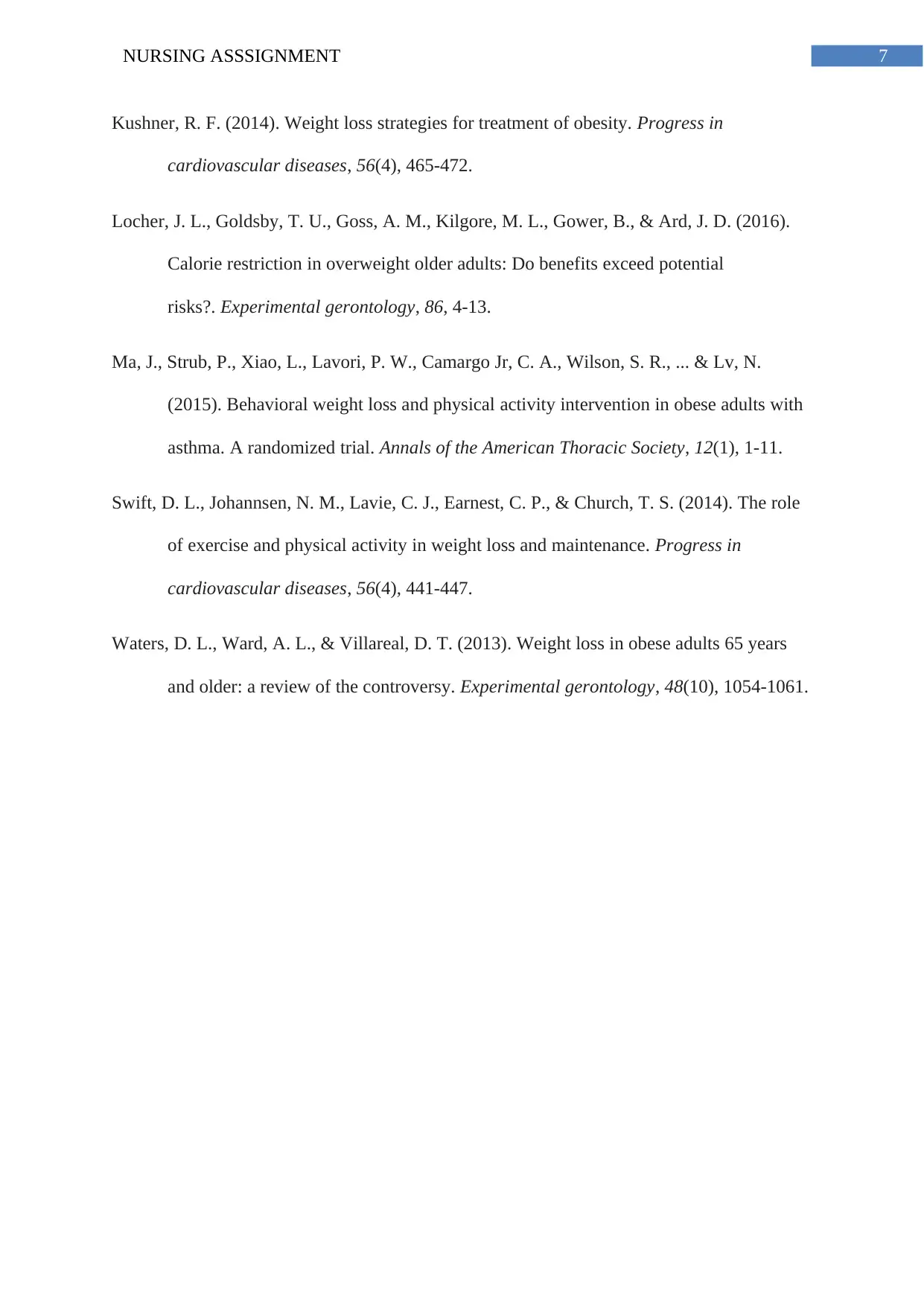
7NURSING ASSSIGNMENT
Kushner, R. F. (2014). Weight loss strategies for treatment of obesity. Progress in
cardiovascular diseases, 56(4), 465-472.
Locher, J. L., Goldsby, T. U., Goss, A. M., Kilgore, M. L., Gower, B., & Ard, J. D. (2016).
Calorie restriction in overweight older adults: Do benefits exceed potential
risks?. Experimental gerontology, 86, 4-13.
Ma, J., Strub, P., Xiao, L., Lavori, P. W., Camargo Jr, C. A., Wilson, S. R., ... & Lv, N.
(2015). Behavioral weight loss and physical activity intervention in obese adults with
asthma. A randomized trial. Annals of the American Thoracic Society, 12(1), 1-11.
Swift, D. L., Johannsen, N. M., Lavie, C. J., Earnest, C. P., & Church, T. S. (2014). The role
of exercise and physical activity in weight loss and maintenance. Progress in
cardiovascular diseases, 56(4), 441-447.
Waters, D. L., Ward, A. L., & Villareal, D. T. (2013). Weight loss in obese adults 65 years
and older: a review of the controversy. Experimental gerontology, 48(10), 1054-1061.
Kushner, R. F. (2014). Weight loss strategies for treatment of obesity. Progress in
cardiovascular diseases, 56(4), 465-472.
Locher, J. L., Goldsby, T. U., Goss, A. M., Kilgore, M. L., Gower, B., & Ard, J. D. (2016).
Calorie restriction in overweight older adults: Do benefits exceed potential
risks?. Experimental gerontology, 86, 4-13.
Ma, J., Strub, P., Xiao, L., Lavori, P. W., Camargo Jr, C. A., Wilson, S. R., ... & Lv, N.
(2015). Behavioral weight loss and physical activity intervention in obese adults with
asthma. A randomized trial. Annals of the American Thoracic Society, 12(1), 1-11.
Swift, D. L., Johannsen, N. M., Lavie, C. J., Earnest, C. P., & Church, T. S. (2014). The role
of exercise and physical activity in weight loss and maintenance. Progress in
cardiovascular diseases, 56(4), 441-447.
Waters, D. L., Ward, A. L., & Villareal, D. T. (2013). Weight loss in obese adults 65 years
and older: a review of the controversy. Experimental gerontology, 48(10), 1054-1061.
1 out of 8
Related Documents
Your All-in-One AI-Powered Toolkit for Academic Success.
+13062052269
info@desklib.com
Available 24*7 on WhatsApp / Email
![[object Object]](/_next/static/media/star-bottom.7253800d.svg)
Unlock your academic potential
Copyright © 2020–2025 A2Z Services. All Rights Reserved. Developed and managed by ZUCOL.





